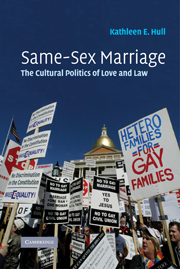Book contents
- Frontmatter
- Contents
- List of tables
- Preface
- Same-sex marriage timeline
- 1 Marriage, culture and law
- 2 Doing the rite thing: cultural practices of commitment
- 3 How do I love thee? Questioning the marriage model
- 4 Making it legal: marriage, law and legality
- 5 Sin or civil right? Debating marriage in the states
- 6 Conclusion: marriage and beyond
- Epilogue
- Appendix A Interview guides
- Appendix B Sample characteristics
- Appendix C Study participants
- Notes
- Court cases
- References
- Index
Appendix A - Interview guides
Published online by Cambridge University Press: 05 June 2012
- Frontmatter
- Contents
- List of tables
- Preface
- Same-sex marriage timeline
- 1 Marriage, culture and law
- 2 Doing the rite thing: cultural practices of commitment
- 3 How do I love thee? Questioning the marriage model
- 4 Making it legal: marriage, law and legality
- 5 Sin or civil right? Debating marriage in the states
- 6 Conclusion: marriage and beyond
- Epilogue
- Appendix A Interview guides
- Appendix B Sample characteristics
- Appendix C Study participants
- Notes
- Court cases
- References
- Index
Summary
INTERVIEW GUIDE – MEMBERS OF SAME-SEX COUPLES
Note: Topics enclosed in brackets ([]) were discussed only with people who had participated in a public commitment ritual, and topics enclosed in arrowheads (<>) were discussed only with people who had not participated in a public commitment ritual.
Start of interview: explanation of research project, discussion of confidentiality protections and request for permission to tape interview.
BASIC SOCIAL BACKGROUND INFORMATION
personal/family history (inquire about parents' marriage)
past and current socioeconomic status (occupation of self/partner; home rent or own)
education – highest attained
family history
age
racial/ethnic identity
religious identification
political orientation
sexual identity
YOUR “COMING OUT” STORY
when and how you came to identify as gay/lesbian/bisexual/other
subjective experience of process
relationship history
views on the nature of sexual identity (constructed vs. essentialist)
HISTORY OF YOUR CURRENT COMMITTED RELATIONSHIP
its beginnings
its evolution (development stages; levels of commitment; crises) and duration
[THE “WEDDING” STORY
decision to construct a ritual
material representations of event (review together)
components of ritual: program; rings; vows; participants, etc.
meaning of the event
personal and social reactions to the event]
ONGOING CONTENT OF THE RELATIONSHIP [AND IMPACT OF RITUAL ON THE RELATIONSHIP]
perceived impact of ritual on relationship
division of labor
management of finances
legal arrangements to establish protections and mutual understandings
sexual and emotional fidelity
status of the relationship within extended families and friendship networks
terminology for status (e.g. “married”) and partner (e.g. “spouse”)
how to answer the question “Are you married?”
plans for having children or other dependents
< DECISION NOT TO HAVE A PUBLIC RITUAL
contributing factors (political, philosophical, personal, etc.)
views on commitment rituals of other same-sex couples
whether there might be a ritual in future, what factors would influence that decision>
Information
- Type
- Chapter
- Information
- Same-Sex MarriageThe Cultural Politics of Love and Law, pp. 224 - 227Publisher: Cambridge University PressPrint publication year: 2006
